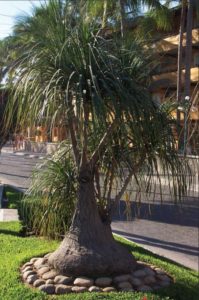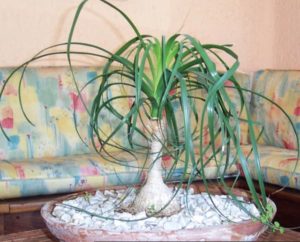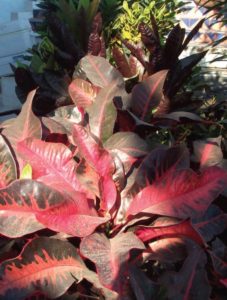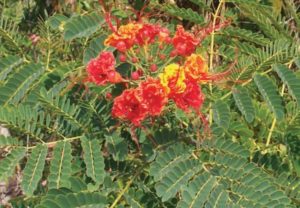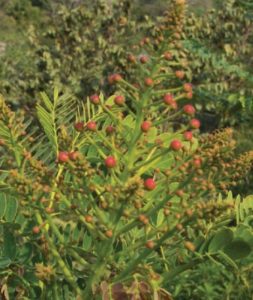Three beautiful options for your tropical garden in Mexico are the ponytail palm, croton and dwarf poinciana.
Ponytail palm (Beaucarnea recurvata)
Family: Agavaceae
Alternate name: Elephant’s Foot
Use: The ponytail palm is a tropical landscape specimen. It can be grown indoors as a potted plant, and is also grown as a bonsai.
Cultivation: The ponytail palm is a hardy, forgiving plant for a wide range of conditions. It thrives in light well-draining soil. This palm prefers bright sun but tolerates a variety of light conditions and should be watered lightly. It will withstand drought, as the bulb-shaped base stores water. However, it has no defense against over-watering.
The ponytail palm grows slowly to a height of 30 feet. Its foliage can be cut back to the base and it will re-grow. If it is overwatered, the roots will attract mealy bugs.
Propagation: From seed.
Note: Its leaves are knife-sharp.
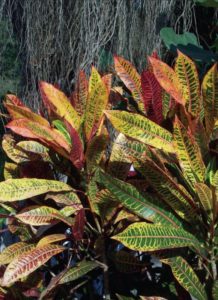 Popular in the Mexican garden, croton is usually a hedge or foundation plant. © Linda Abbott Trapp 2009
Popular in the Mexican garden, croton is usually a hedge or foundation plant. © Linda Abbott Trapp 2009
Croton (Codiaeum variegatum)
Family: Euphorbiaceae
Use: Croton is usually a hedge or foundation plant, or specimen shrub. It is also used as potted plant.
Flowers: Croton produces narrow terminal racemes of insignificant white flowers. The plants are grown for the spectacularly colorful and shapely leaves.
Cultivation: Crotons like full sun for maximum color, which ranges from pink, red, yellow, orange, green, to nearly black. Sits many variations include speckled and striped leaves, and exhibit a great deal of variety in leaf shape.
Enrich the soil with compost and peat moss, and fertilize crotons three times a year. Shelter the plants from wind and water them frequently. The croton grows to a height of 8 to 10 feet in a warm climate, but does not transplant well. Inspect your plants for spider mites.
Propagation: Croton can be propagated from greenwood cuttings, leaf bud cuttings, or air layering. Root them in a sand/peat moss mixture.
Note: There may be more named cultivars of this species than of any other tropical ornamental. There are few drawbacks to the croton, however there may be some staining from latex sap, and a low level toxicity to mammals.
Dwarf Poinciana (Caesalpinia pulcherrima)
Family: Caesalpinia
Alternate Names: Barbados Pride, Peacock Flower
Use: The dwarf poinciana is a small-tree-size shrub, with attractive multihued flowers. It is excellent along walls, and as hedge border. It can be used to border walkways, but some varieties have thorns. The plant can be greenhouse grown in temperate climates.
Flowers: The dwarf poinciana blooms in orange-red and yellow flowers with long, protruding red stamens that appear throughout the year, borne on long stalks in terminal racemes. C. flava has yellow flowers. The flowers and leaves somewhat resemble the poinciana tree.
Cultivation: The dwarf poinciana is native to tropical America. The shrub grows to 13 feet or more in full sun to part shade. It prefers fertile well-drained soil, and light, regular watering.
Propagation: This plant can be propagated by tip cuttings placed in a sandy soil mixture with high humidity, or by seeds soaked in warm water prior to sowing.

